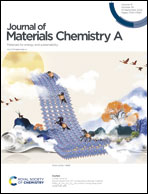MgO-template synthesis of hollow N/O dual-doped carbon boxes as extremely stable anodes for potassium-ion batteries†
Abstract
The abundant resources of potassium in the earth have prompted researchers to develop novel-concept potassium-ion batteries (PIBs) with higher energy density. Carbon-based materials are considered to be promising candidates as anodes in PIBs due to their low price, rich sources, fast electron transfer and environmental friendliness. However, they still face the challenges of low capacity and fast capacity fading during cycling. Herein, a strategy of a hollow cubic shape with porous structure has been developed to prepare hollow N/O dual-doped carbon boxes (H-NOCBs) by the three main steps of MgO template synthesis, the polymerization of dopamine on the MgO surface as well as the subsequent calcination of the mixture, and the etching of the MgO templates. The H-NOCBs exhibit superior cycling stability with the retained capacities of 178.8 mA h g−1 (500 mA g−1) and 123.3 mA h g−1 (1000 mA g−1) after 2500 and 10 000 cycles, respectively. The larger interlayer spacing and unique hollow shape with a porous structure could accommodate more potassium ions into the carbon matrix and relieve the volume expansion, contributing to a higher capacity and longer cycle life performance. The achievements in this work shed light on the preparation of outstanding carbon-based anodes for advanced PIBs.



 Please wait while we load your content...
Please wait while we load your content...